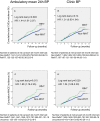Refractory Hypertension and Risks of Adverse Cardiovascular Events and Mortality in Patients With Resistant Hypertension: A Prospective Cohort Study
- PMID: 32851922
- PMCID: PMC7660786
- DOI: 10.1161/JAHA.120.017634
Refractory Hypertension and Risks of Adverse Cardiovascular Events and Mortality in Patients With Resistant Hypertension: A Prospective Cohort Study
Abstract
Background The long-term prognosis of refractory hypertension (RfHT), defined as failure to control blood pressure (BP) levels despite an antihypertensive treatment with ≥5 medications including a diuretic and mineraloreceptor antagonist, has never been evaluated. Methods and Results In a prospective cohort study with 1576 patients with resistant hypertension, patients were classified as refractory or nonrefractory based on uncontrolled clinic (or office) and ambulatory BPs during the first 2 years of follow-up. Multivariate Cox analyses examined the associations between the diagnosis of RfHT and the occurrence of total cardiovascular events (CVEs), major adverse CVEs, and cardiovascular and all-cause mortality, after adjustments for other risk factors. In total, 135 patients (8.6%) had RfHT by uncontrolled ambulatory BPs and 167 (10.6%) by uncontrolled clinic BPs. Over a median Follow-Up of 8.9 years, 338 total CVEs occurred (288 major adverse CVEs, including 124 myocardial infarctions, and 96 strokes), and 331 patients died, 196 from cardiovascular causes. The diagnosis of RfHT, using either classification by clinic or ambulatory BPs, was associated with significantly higher risks of major adverse CVEs, cardiovascular mortality, and stroke incidence, with hazard ratios varying from 1.54 to 2.14 in relation to patients with resistant nonrefractory hypertension; however, the classification based on ambulatory BPs was better in identifying higher risk patients than the classification based on clinic BP levels. Conclusions Patients with RfHT, particularly when defined by uncontrolled ambulatory BP levels, had higher risks of major adverse CVEs and mortality in relation to patients with resistant but nonrefractory hypertension, supporting the concept of refractory hypertension as a true extreme phenotype of antihypertensive treatment failure.
Keywords: ambulatory blood pressure monitoring; cardiovascular events; cohort study; mortality; refractory hypertension; risk factors.
Conflict of interest statement
None.
Figures


Similar articles
-
Prognostic Importance of On-Treatment Clinic and Ambulatory Blood Pressures in Resistant Hypertension: A Cohort Study.Hypertension. 2020 May;75(5):1184-1194. doi: 10.1161/HYPERTENSIONAHA.120.14782. Epub 2020 Mar 23. Hypertension. 2020. PMID: 32200673
-
Prognostic impact of clinic and ambulatory blood pressure components in high-risk type 2 diabetic patients: the Rio de Janeiro Type 2 Diabetes Cohort Study.J Hypertens. 2013 Nov;31(11):2176-86. doi: 10.1097/HJH.0b013e328364103f. J Hypertens. 2013. PMID: 24029864
-
[Resistant hypertension and the risk of major adverse cardiac and cerebrovascular events in outpatients].Zhonghua Xin Xue Guan Bing Za Zhi. 2024 Aug 24;52(8):884-891. doi: 10.3760/cma.j.cn112148-20240415-00204. Zhonghua Xin Xue Guan Bing Za Zhi. 2024. PMID: 39143779 Chinese.
-
Refractory Hypertension: a Narrative Systematic Review with Emphasis on Prognosis.Curr Hypertens Rep. 2022 Apr;24(4):95-106. doi: 10.1007/s11906-022-01165-w. Epub 2022 Feb 2. Curr Hypertens Rep. 2022. PMID: 35107787
-
Prognostic Effect of the Nocturnal Blood Pressure Fall in Hypertensive Patients: The Ambulatory Blood Pressure Collaboration in Patients With Hypertension (ABC-H) Meta-Analysis.Hypertension. 2016 Apr;67(4):693-700. doi: 10.1161/HYPERTENSIONAHA.115.06981. Epub 2016 Feb 22. Hypertension. 2016. PMID: 26902495 Review.
Cited by
-
Systolic Blood Pressure and Pulse Pressure Are Predictors of Future Cardiovascular Events in Patients with True Resistant Hypertension.Diagnostics (Basel). 2023 May 22;13(10):1817. doi: 10.3390/diagnostics13101817. Diagnostics (Basel). 2023. PMID: 37238300 Free PMC article.
-
The Effect of Renal Denervation on T Cells in Patients with Resistant Hypertension.Int J Mol Sci. 2023 Jan 27;24(3):2493. doi: 10.3390/ijms24032493. Int J Mol Sci. 2023. PMID: 36768814 Free PMC article.
-
An Update on Refractory Hypertension.Curr Hypertens Rep. 2022 Jul;24(7):225-234. doi: 10.1007/s11906-022-01185-6. Epub 2022 Apr 6. Curr Hypertens Rep. 2022. PMID: 35384577 Free PMC article. Review.
-
Factor associated with and risk of cardiovascular disease in people with uncontrolled hypertension.Sci Rep. 2025 Jan 2;15(1):375. doi: 10.1038/s41598-024-84824-z. Sci Rep. 2025. PMID: 39748021 Free PMC article.
-
Renal Denervation for Resistant Hypertension: A Concise Update on Treatment Options and the Latest Clinical Evidence.Cardiol Ther. 2022 Sep;11(3):385-392. doi: 10.1007/s40119-022-00275-5. Epub 2022 Aug 9. Cardiol Ther. 2022. PMID: 35943714 Free PMC article. Review.
References
-
- Carey RM, Calhoun DA, Bakris GL, Brook RD, Daugherty SL, Dennison-Himmelfarb CR, Egan BM, Flack JM, Gidding SS, Judd E, et al.; American Heart Association Professional/Public Education and Publications Committee of the Council on Hypertension; Council on Cardiovascular and Stroke Nursing; Council on Clinical Cardiology; Council on Genomic and Precision Medicine; Council on Peripheral Vascular Disease; Council on Quality of Care and Outcomes Research; and Stroke Council . Resistant hypertension: detection, evaluation, and management: a scientific statement from the American Heart Association. Hypertension. 2018;72:e53–e90. - PMC - PubMed
-
- de la Sierra A, Banegas JR, Oliveras A, Gorostidi M, Segura J, de la Cruz JJ, Armario P, Ruilope LM. Clinical differences between resistant hypertensives and patients treated and controlled with three or less drugs. J Hypertens. 2012;30:1211–1216. - PubMed
-
- Muxfeldt ES, de Souza F, Margallo VS, Salles GF. Cardiovascular and renal complications in patients with resistant hypertension. Curr Hypertens Rep. 2014;16:471. - PubMed
Publication types
MeSH terms
Substances
LinkOut - more resources
Full Text Sources
Medical

